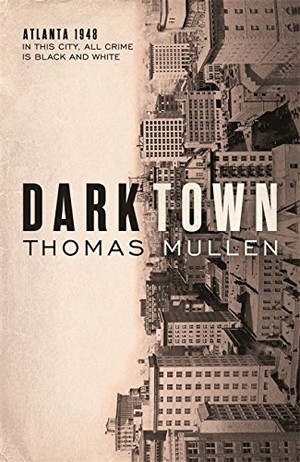 So many countries are divided on the issues of race and identity at the moment that Thomas Mullen’s latest novel is born into a world of vitriol. Set in Atlanta in 1948, and written in tribute to the city’s first black policemen who joined the force in that year, it’s certainly a fictional account with race at its core.
So many countries are divided on the issues of race and identity at the moment that Thomas Mullen’s latest novel is born into a world of vitriol. Set in Atlanta in 1948, and written in tribute to the city’s first black policemen who joined the force in that year, it’s certainly a fictional account with race at its core.
We meet officers Boggs and Smith, walking the beat in Darktown. It’s not called Darktown just because it’s the negro quarter – for years the area has done without amenities like reliable street lights. Tonight, Boggs and Smith see a strange event – a white man crashes his car into a working street lamp, toppling it, and attempts to drive away. They stop him and notice a young black woman in a yellow dress in his car, but he waves them off with vague threats.
1948 Atlanta is not ready to allow black officers to carry guns or drive squad cars, so they have to call it in by pay phone. White officers Dunlow and Rakestraw respond and actually manage to catch up with streetlamp smasher Underhill, but the burly racist Dunlow lets him go on his way, gleefully undermining Smith and Boggs. A few days later the woman in the yellow dress turns up dead in a derelict lot – shot through the heart.
Smith and Boggs feel guilty at not being firmer with Underhill, who has gone to ground. Denny Rakestraw, a rookie who secretly hates his racist partner Dunlow, also regrets not doing more. Smith and Boggs aren’t detectives and as black officers would face severe consequences if they meddled in a murder, but nevertheless start their own investigation. In parallel, WWII hero Rakestraw starts sleuthing in his spare time. They all have to tread carefully in a city deeply divided between black and white.
Mullen nicely sets up his mystery, while demonstrating the burning unfairness of segregation. The black officers aren’t even allowed into the city’s police station. When Boggs does venture in he’s openly called ‘boy’ and ‘nigger’, and threatened by supposedly fellow cops. HQ for the coloured officers is the basement of a YMCA in Darktown, where mildew climbs the walls and the floor isn’t even concreted over. Their white superior, McInnis, loathes working there with his black team and is altering their paperwork. Across town, the white detectives try and pin the girl’s murder on the first negro they can – her father, who has travelled to Atlanta to identify the body.
The picture grows more and more bleak, and the oppressive racism that Mullen describes threatens to suffocate his plot. But he’s a subtle writer, and having established the perils his main players face in the first third of the book, his story and characters then begin to grow in complexity. There’s the young woman’s background in the country, for instance. And hints at widespread corruption in the white part of the force. Dunlow is profiting from moonshine and prostitution rackets in the black neighbourhoods. Meanwhile, Rakestraw’s own brother wants to burn down a negro’s house…
It feels as if men in white hoods are just around every shadowy corner, but Smith, Boggs and Rakestraw begin to make progress and even collaborate. Trouble is, whenever they do something that might help achieve justice for the dead girl, there are unintended consequences and new victims. Smith and Boggs are particularly exposed when they venture into the countryside to find out more about her family. The threat of violence is far worse there than in the relative safety of Atlanta’s black districts.
The nasty racist atmosphere hangs there in the book, and as a political angle emerges in the plot you also realise that the black characters are constantly choosing between fighting for justice or getting on with some semblance of a normal life. It’s very interesting that not only does the author look at the issues of black and white, but at old versus young. Boggs, the son of a preacher, is frustrated at how the prosperous blacks he’s grown up with prefer to live in their bubble on Auburn Avenue, not wanting to push for real change. Rakestraw sees his fellow whites inherit racist attitudes from prior generations but finds it hard to confront them.
For Boggs, Smith and Rakestraw, it comes down to bravery. None of them are proper detectives but they muddle their way through the case of the dead girl making all sorts of mistakes. Whether she receives justice or not really comes down to a few key confrontations in which these three men – forces for progress in their own way – cannot afford to waver. With the tension Mullen creates pulling tight the strings of his plot, it’s no surprise this book is destined for a TV series in the US. Read it.
For another look at inequality in the Atlanta police, try Karin Slaughter’s Cop Town.
Simon & Schuster
Print/Kindle/iBook
£7.99
CFL Rating: 5 Stars








I love crime stories and I am very interested in Forensics. would love this book please.
They are allowed to carry firearms “which terrifies a number of people in Atlanta and beyond.”
Otherwise, great review; fantastic book. Can see it on a lot of end-of-year “Best Of…” lists (including my own, probably!)